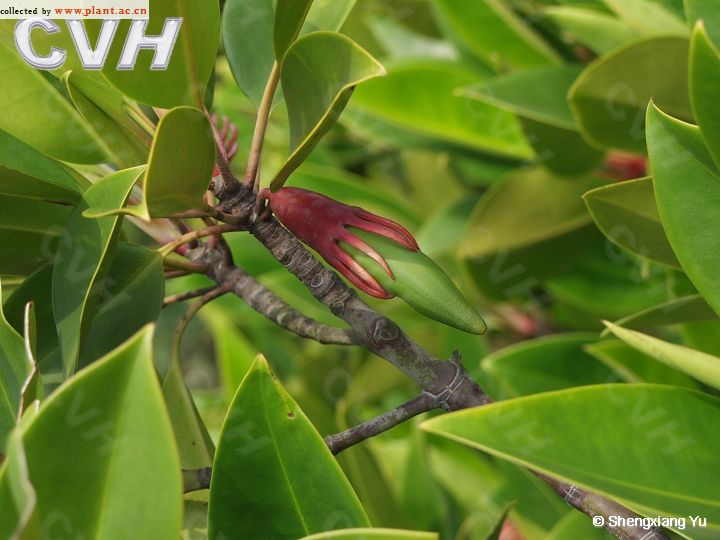木榄Bruguiera gymnorrhiza (Linn.) Savigny
木榄Bruguiera gymnorrhiza (Linn.) Savigny
1.木榄(广西钦县)包罗剪定(广东徐闻),鸡爪浪(广东台山),剪定、枷定(广东海南),大头榄、鸡爪榄(广西合浦),五脚里、五梨蛟(台湾)
Bruguiera gymnorrhiza (Linn.) “Poir. in Lam., Tabl. Enc. (Text.) 2: 517. 1794, nom. inval. ; Lam., Tabl. Enc. 1: t. 397. 1797, sine nom. sp. ; ”Savigny in Lam., Enc. 4: 697. 1798 (as B. gymnorrhiza); Henslow in Hook. f. Fl. Brit. Ind. 2: 437. 1878; 海南植物志2: 443. 1965; 中国高等植物图鉴2: 982.图3693.1972. ——Rhizophora gymnorrhiza Linn., Sp. Pl. 443. 1753.——B. conjugata auct non Rhazophora conjugata Linn.: Merr. in Phiiip. Journ. Sci. Bot. 9: 118. 1914; Kanehira, Formos. Trees Rev. ed. 491. f. 453. 1936; How et Ho in Acta Phytotax. Sinica 2: 139. Pl. 23. 1953.——B. cylindrica acct. non Bl.: Hrance in Journ. Bot. 18: 10. 1879.
乔木或灌木;树皮灰黑色,有粗糙裂纹。叶椭圆状矩圆形,长7-15厘米,宽3-5.5厘米,顶端短尖,基部楔形;叶柄暗绿色,长2.5-4.5厘米;托叶长3-4厘米,淡红色。花单生,盛开时长3-3.5厘米,有长1.2-2.5厘米的花梗;萼平滑无棱,暗黄红色,裂片11-13;花瓣长1.1-1.3厘米,中部以下密被长毛,上部无毛或几无毛,2裂,裂片顶端有2-3(-4 )条刺毛,裂缝间具刺毛1条;雄蕊略短于花瓣;花柱3-4棱柱形,长约2厘米,黄色,柱头3-4裂。胚轴长15-25厘米。花果期几全年。
产广东、广西、福建、台湾及其沿海岛屿;生于浅海盐滩。分布于非洲东南部、印度、斯里兰卡、马来西亚、泰国、越南、澳大利亚北部及波利尼西亚。模式标本采自印度。
本种在我国分布广,是构成我国红树林的优势树种之一,喜生于稍干旱、空气流通、伸向内陆的盐滩。据报道在马来西亚地区多成纯林,树高20多米,直径65厘米,但在我国,目前所发现的其树高很少超过6米,亦未见有纯林,多散生于秋茄树的灌丛中。材质坚硬,色红,很少作土工木料,多用作燃料。树皮含单宁19%-20%。
种中文名:木榄
种拉丁名:Bruguiera gymnorrhiza (Linn.) Savigny
科中文名:红树科
科拉丁名:Rhizophoraceae
属中文名:木榄属
属拉丁名:Bruguiera
国内分布:广东、广西、福建、台湾及其沿海岛屿
国外分布:非洲东南部、印度、斯里兰卡、马来西亚、泰国、越南、澳大利亚北部、波利尼西亚
【药 名】:木榄
【拼 音】:MULAN
【来 源】:为红树科植物木榄的树皮。
【功 效】:收敛止泻。
【主 治】:用于腹泻,脾虚、肾虚。
【性味归经】:涩,平。大肠经。
【用法用量】:内服:煎汤,3-9克。
【别 名】:红树(《中国树木分类学》)、铁榄、大头榄(《中国高等植物图鉴》)、五梨跤、五脚里(台湾)
【动植物资源分布】:分布于台湾、广东、海南、广西等省区。
【拉丁名】:木榄Bruguiera gymnoihiza (L.) Savigny.
【考 证】:始载于《植物分类学报》。
【中药化学成分】:植株含木榄醇(gymnorhizo),叶含谷甾醇、豆甾醇、28-异岩藻甾醇(28- isofucosterol)与赤霉素 A3, A4,A7。
《Flora of China》 Vol. 13 (2007)
Bruguiera gymnorhiza (Linnaeus) Savigny
木榄 mu lan
Rhizophora gymnorhiza Linnaeus, Sp. Pl. 1: 443. 1753; Bruguiera conjugata (Linnaeus) Merrill; R. conjugata Linnaeus.
Trees 6-20 m tall, d.b.h. 30-60 cm. Bark gray, deeply fissured. Stipules often reddish, ca. 4 cm, interpetiolar, caducous. Petiole 2-4.5 cm; leaf blade elliptic-oblong, 8-21 × 4-7(-9) cm, leathery, glabrous, base cuneate to rarely obtuse, apex acute. Pedicel 1-2.5 cm. Flowers in axils of upper leaves, solitary, red or pinkish red, ca. 3 cm. Calyx lobes 10-14, linear, 1.5-2 cm, glabrous. Petals 12-14, 1.3-1.5 cm, outer margin fringed with white silky hairs; sinus bristles 3 or 4 per petal, 2-3 mm, distinctly exceeding petals. Stamens twice as many as petals, 8-11 mm; filaments filiform; anthers linear to lanceolate, 4-5 mm. Disk cup-shaped. Ovary inferior, 3-loculed; style filiform, ca. 1.5 cm; stigma lobes 3 or 4. Fruit adnate to calyx tube, ca. 2.5 mm; persistent calyx on fruit or hypocotyls ribbed only apically. Seed 1, viviparous. Hypocotyl cigar-shaped, slightly angular, 15-25 × 1.5-2 cm. Fl. May-Jun. 2n = 26.
Mangrove forests; sea level. S Fujian, Guangdong, S Guangxi, Hainan, SW Taiwan (extinct) [Cambodia, India, Indonesia, Japan (Ryukyu Islands), Malaysia, Myanmar, Philippines, Sri Lanka, Thailand, Vietnam; E Africa, N Australia, Indian Ocean islands, Madagascar, New Guinea, Pacific islands].
Bruguiera gymnorhiza and Ceriops tagal were originally found among the mangroves of Gaoxiong (Kaohsiung) lagoon, Taiwan. Both species completely disappeared after 12 years (1956-1968) of expansion and second-stage construction of the harbor (1967-1977). The last gathering records indicate that in 1959 only 22 individuals of B. gymnorhiza and one individual of C. tagal remained in the lagoon (C. F. Hsieh, pers. comm.). According to C.-I Peng (pers. comm.), B. gymnorhiza disappeared from Taiwan in the 1960s.
别名:铁榄;大头榄;五跤梨;包罗剪定;包萝剪定;包蘿剪定;长鼓;大叶格拿稍;鸡爪榄;鸡爪浪;枷定;剪定;五脚里;五梨蛟;五梨蚊;
科名:红树科 Rhizophoraceae
属名:木榄属 Bruguiera

1.木榄(广西钦县)包罗剪定(广东徐闻),鸡爪浪(广东台山),剪定、枷定(广东海南),大头榄、鸡爪榄(广西合浦),五脚里、五梨蛟(台湾)
Bruguiera gymnorrhiza (Linn.) “Poir. in Lam., Tabl. Enc. (Text.) 2: 517. 1794, nom. inval. ; Lam., Tabl. Enc. 1: t. 397. 1797, sine nom. sp. ; ”Savigny in Lam., Enc. 4: 697. 1798 (as B. gymnorrhiza); Henslow in Hook. f. Fl. Brit. Ind. 2: 437. 1878; 海南植物志2: 443. 1965; 中国高等植物图鉴2: 982.图3693.1972. ——Rhizophora gymnorrhiza Linn., Sp. Pl. 443. 1753.——B. conjugata auct non Rhazophora conjugata Linn.: Merr. in Phiiip. Journ. Sci. Bot. 9: 118. 1914; Kanehira, Formos. Trees Rev. ed. 491. f. 453. 1936; How et Ho in Acta Phytotax. Sinica 2: 139. Pl. 23. 1953.——B. cylindrica acct. non Bl.: Hrance in Journ. Bot. 18: 10. 1879.
乔木或灌木;树皮灰黑色,有粗糙裂纹。叶椭圆状矩圆形,长7-15厘米,宽3-5.5厘米,顶端短尖,基部楔形;叶柄暗绿色,长2.5-4.5厘米;托叶长3-4厘米,淡红色。花单生,盛开时长3-3.5厘米,有长1.2-2.5厘米的花梗;萼平滑无棱,暗黄红色,裂片11-13;花瓣长1.1-1.3厘米,中部以下密被长毛,上部无毛或几无毛,2裂,裂片顶端有2-3(-4 )条刺毛,裂缝间具刺毛1条;雄蕊略短于花瓣;花柱3-4棱柱形,长约2厘米,黄色,柱头3-4裂。胚轴长15-25厘米。花果期几全年。
产广东、广西、福建、台湾及其沿海岛屿;生于浅海盐滩。分布于非洲东南部、印度、斯里兰卡、马来西亚、泰国、越南、澳大利亚北部及波利尼西亚。模式标本采自印度。
本种在我国分布广,是构成我国红树林的优势树种之一,喜生于稍干旱、空气流通、伸向内陆的盐滩。据报道在马来西亚地区多成纯林,树高20多米,直径65厘米,但在我国,目前所发现的其树高很少超过6米,亦未见有纯林,多散生于秋茄树的灌丛中。材质坚硬,色红,很少作土工木料,多用作燃料。树皮含单宁19%-20%。
种中文名:木榄
种拉丁名:Bruguiera gymnorrhiza (Linn.) Savigny
科中文名:红树科
科拉丁名:Rhizophoraceae
属中文名:木榄属
属拉丁名:Bruguiera
国内分布:广东、广西、福建、台湾及其沿海岛屿
国外分布:非洲东南部、印度、斯里兰卡、马来西亚、泰国、越南、澳大利亚北部、波利尼西亚
【药 名】:木榄
【拼 音】:MULAN
【来 源】:为红树科植物木榄的树皮。
【功 效】:收敛止泻。
【主 治】:用于腹泻,脾虚、肾虚。
【性味归经】:涩,平。大肠经。
【用法用量】:内服:煎汤,3-9克。
【别 名】:红树(《中国树木分类学》)、铁榄、大头榄(《中国高等植物图鉴》)、五梨跤、五脚里(台湾)
【动植物资源分布】:分布于台湾、广东、海南、广西等省区。
【拉丁名】:木榄Bruguiera gymnoihiza (L.) Savigny.
【考 证】:始载于《植物分类学报》。
【中药化学成分】:植株含木榄醇(gymnorhizo),叶含谷甾醇、豆甾醇、28-异岩藻甾醇(28- isofucosterol)与赤霉素 A3, A4,A7。
《Flora of China》 Vol. 13 (2007)
Bruguiera gymnorhiza (Linnaeus) Savigny
木榄 mu lan
Rhizophora gymnorhiza Linnaeus, Sp. Pl. 1: 443. 1753; Bruguiera conjugata (Linnaeus) Merrill; R. conjugata Linnaeus.
Trees 6-20 m tall, d.b.h. 30-60 cm. Bark gray, deeply fissured. Stipules often reddish, ca. 4 cm, interpetiolar, caducous. Petiole 2-4.5 cm; leaf blade elliptic-oblong, 8-21 × 4-7(-9) cm, leathery, glabrous, base cuneate to rarely obtuse, apex acute. Pedicel 1-2.5 cm. Flowers in axils of upper leaves, solitary, red or pinkish red, ca. 3 cm. Calyx lobes 10-14, linear, 1.5-2 cm, glabrous. Petals 12-14, 1.3-1.5 cm, outer margin fringed with white silky hairs; sinus bristles 3 or 4 per petal, 2-3 mm, distinctly exceeding petals. Stamens twice as many as petals, 8-11 mm; filaments filiform; anthers linear to lanceolate, 4-5 mm. Disk cup-shaped. Ovary inferior, 3-loculed; style filiform, ca. 1.5 cm; stigma lobes 3 or 4. Fruit adnate to calyx tube, ca. 2.5 mm; persistent calyx on fruit or hypocotyls ribbed only apically. Seed 1, viviparous. Hypocotyl cigar-shaped, slightly angular, 15-25 × 1.5-2 cm. Fl. May-Jun. 2n = 26.
Mangrove forests; sea level. S Fujian, Guangdong, S Guangxi, Hainan, SW Taiwan (extinct) [Cambodia, India, Indonesia, Japan (Ryukyu Islands), Malaysia, Myanmar, Philippines, Sri Lanka, Thailand, Vietnam; E Africa, N Australia, Indian Ocean islands, Madagascar, New Guinea, Pacific islands].
Bruguiera gymnorhiza and Ceriops tagal were originally found among the mangroves of Gaoxiong (Kaohsiung) lagoon, Taiwan. Both species completely disappeared after 12 years (1956-1968) of expansion and second-stage construction of the harbor (1967-1977). The last gathering records indicate that in 1959 only 22 individuals of B. gymnorhiza and one individual of C. tagal remained in the lagoon (C. F. Hsieh, pers. comm.). According to C.-I Peng (pers. comm.), B. gymnorhiza disappeared from Taiwan in the 1960s.
- 引进红树拉关木和两种乡土红树离子平衡及光合作用的比较研究
- 深圳湾红树木榄根系生物量及空间分布格局
- 木榄胎生繁殖体产量预测模型
- 红树植物木榄种群高度结构的分形特征
- 红树植物木榄(Bruguiera gymnorrhiza)种群的交配系统
- 盐胁迫对木榄幼苗各器官热值、能量积累及分配的影响
- 盐度对木榄幼苗某些金属元素累积的影响及钙的效应
- 红树植物木榄有机溶剂提取物对球形棕囊藻的抑制效应
- 木榄CaM基因的克隆及序列分析
- 木榄和秋茄对水渍的生长与生理反应的比较研究
- 盐胁迫下木榄幼苗叶片的解剖学变化
- 广西英罗湾红海榄和木榄两种红树群落小气候的初步研究(简报)
- 红树林植物木榄水通道基因的克隆和表达
- 木榄林生物量的灰色动态预测
- PGPB对红树植物木榄幼苗的接种效应
- 木榄种源引种深圳湾后幼苗生理生态研究
- 红树植物木榄胚轴中的挥发性成分和脂肪酸成分分析
- 中国红树植物柱果木榄 (红树科) 考证
- 红树植物木榄的活性成分研究概况
- 红树植物木榄幼树斑块形状的分形分析
- 广西的红树林
- 红树植物木榄胚轴中苯丙素类化学成分研究
- 木榄属3种红树植物的遗传变异和亲缘关系分析
- 木榄属植物的化学成分研究进展
- 不同生境下2种木榄属植物茎次生木质部结构变化的适应性
- 木榄幼苗叶片cDNA文库的构建及其表达序列标签分析
- 三种红树植物叶片的比较解剖学研究
- 广州市南沙红树植物无瓣海桑、木榄人工林生物量的研究
- 深圳湾红树植物木榄种源筛选早期试验
- 木榄林生物量和生产力的研究*
- 人工湿地污水处理系统3种红树植物生理生态特性
- 红树植物人工湿地对生活污水的净化效果
- 木榄、海莲和尖瓣海莲种间亲和性和亲缘关系分析
- 气相色谱-质谱联用法测定红树科植物木榄叶中脂肪酸
- 红树科(Rhizophoraceae)木榄属(Bruguiera)植物3个种的遗传多样性及其亲缘关系
- 红树科(Rhizophoraceae)木榄属(Bruguiera)植物3个种的遗传多样性及其亲缘关系
- 珠海淇澳岛几种红树植物引种的初步研究


